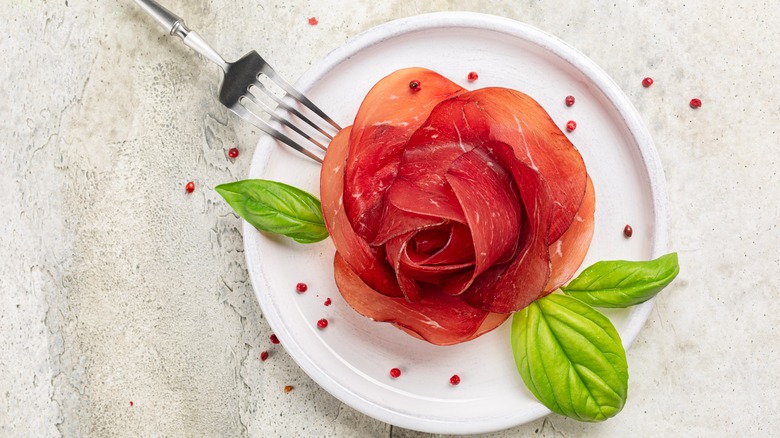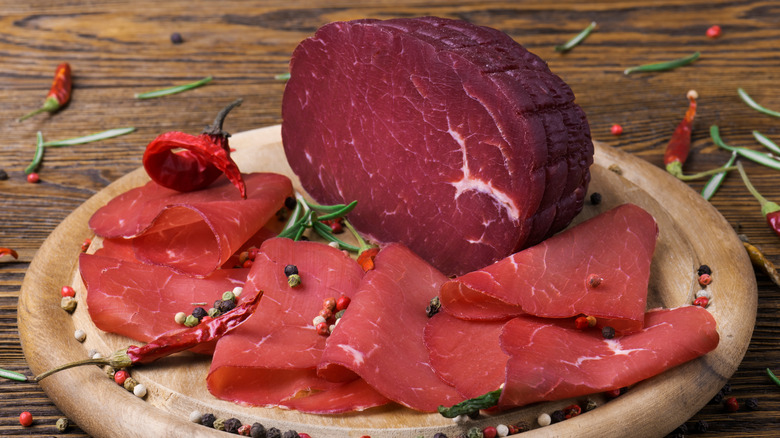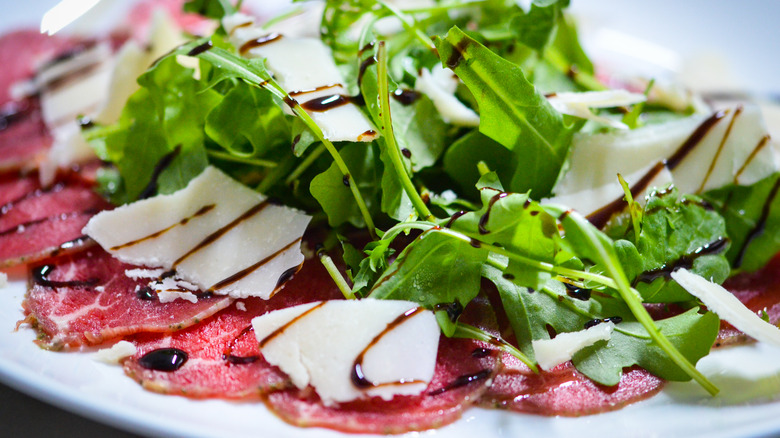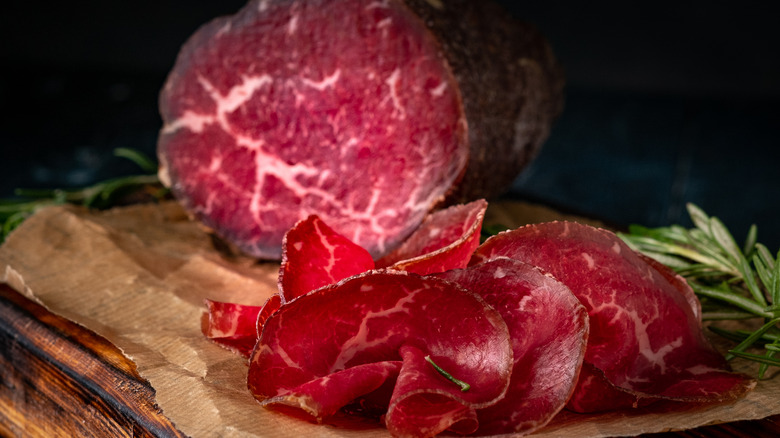What Is Bresaola And How Does It Differ From Other Italian Cured Meats?
Its strikingly gorgeous purple hue should be enough to incite curiosity, but if it isn't, let us be the first to tell you that its deliciously delicate and aromatic profile makes bresaola a one-of-a-kind cured meat. Unlike the typical Italian offerings that fill display cases at delis and decorate charcuterie boards, thinly sliced bresaola is worth seeking out if you're craving charcuterie but are also looking to broaden your cured meat repertoire.
Similar to other salted and dried meats, bresaola was crafted many centuries ago as a means of preservation. A characteristic by-product of Lombardy's cattle-rich rural valleys, many believe that the word bresaola could stem from the German term brasa, meaning ember, coupled with saola, meaning salt — although local lore suggests bresaola may also be a derivation of brisa, which refers to a piece of salted beef in the alpine dialect.
Despite being consumed locally for years, the Consorzio di Tutela Bresaola della Valtellina shares that the lean meat was eventually exported to nearby Swiss cities before expanding into more international markets, which is precisely why you should keep an eye out for it at your local salumeria. But before starting your search for this cured meat, let's dive deeper into what makes bresaola unique.
The basics of bresaola production
Although some versions can be made using horse meat or other such proteins, Bresaola della Valtellina I.G.P. (in English, P.D.O. or Protected Designation of Origin) is strictly made from a few specific cuts of beef. In addition to selecting meat from cows aged between 18 months to 4 years, this highly-prized bresaola must also be produced within the Sondrio district of Lombardy.
The consortium explains that once the highest quality pieces of beef are chosen, skilled butchers are responsible for trimming the meat, removing the bulk fat and tendons, and making sure not to pierce the muscle. At this point, the hunks of beef can be massaged with salt and seasoning, which can consist of any number of ingredients, like a touch of wine or sprinkle of sugar to spices like pepper, cinnamon, or juniper berries. After about 10 days, the bresaola is then placed into a casing before it is hung to air-dry. During the span of a week, temperatures must be kept between 12 to 18 degrees Celcius so the meat can properly dehydrate, losing almost half of its volume in the process. But the bresaola isn't ready just yet.
Left to age for between one and two months, the freshly-made bresaola can now be packaged and sold for our dining pleasure.
Ways to enjoy bresaola
Considering beef bresaola's mild and delicate quality, it can be served on its own (either chilled or at room temperature) to fully taste its subtle sweetness. Alternatively, you could dine as they do in Valtellina and pair the meat with a few curls of butter and local rye bread. But dressing slices with a drizzle of olive oil, lemon juice, and pepper is also a common way to serve the cured meat.
But bresaola is versatile and pairs easily with many fruits, vegetables, and fungi like mushrooms and zucchini to figs and melons. A few slices can also be the perfect addition to crostini and sandwiches or used to top pizza, pasta, or risotto. Not to mention thinly sliced bresaola can be the star of a salad made with arugula and slivers of a funky hard cheese like Grana Padano.
To kick up the creativity, sliced bresaola can create involtini or fagottini (rolls or bundles) that pair the meat with soft cheeses like robiola or ricotta, along with chopped nuts or vegetables. Just don't forget to bring a glass of wine to complement these tasty bites — preferably a bold red like Nebbiolo or an aromatic white such as Roussanne, which contrast with the flavors of the beef.
Beef bresaola is on the leaner side of Italian cured cuts
Aside from an obvious difference in color, the garnet-hued bresaola is made from beef, unlike many other traditional cured meat products made from pork like coppa, soppressata, or lardo. That said, while bresaola might often be branded as a sort of beef prosciutto, it actually has very little marbling when compared to its porkier counterparts. In fact, bresaola is one of the leanest cured meats, given the cut of beef and the fat trimming it undergoes. A high-protein salumi, Bresaola di Valtellina I.G.P., in particular, is defined by its modest calorie count and fat content.
Likewise, the other factor that makes bresaola so unique is its relatively mild flavor, which is partly due to the type of meat and partly due to the way it's processed. While veal boasts a much milder flavor than pork, bresaola is also delicate thanks to being left to air-dry, unlike salumi, such as speck, which is smoked. While these processes each affect the meat differently, bresaola remains one of the healthiest and most versatile cured meat options out there.
With so many special attributes, bresaola is too intriguing not to try. Taste it for yourself and see just how wonderfully unique it is!



